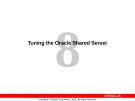
Oracle management server
-
Users and Security Security domain The database administrator defines the names of the users who are allowed to access a database. A security domain defines the settings that apply to the user. Authentication mechanism A user who requires access to the database can be authenticated by one of the following: Data dictionary Operating system Network The means of authentication is specified at the time the user is defined in the database and can be altered later. This lesson covers authentication by database and by operating system only.
 20p
20p  trinh02
trinh02
 28-01-2013
28-01-2013
 83
83
 3
3
 Download
Download
-
After completing this lesson, you should be able to do the following: Identify issues associated with managing users in an Oracle Shared Server environment Configure the Oracle Shared Server environment to optimize performance Diagnose and resolve performance issues with Oracle Shared Server processes
 14p
14p  trinh02
trinh02
 28-01-2013
28-01-2013
 61
61
 5
5
 Download
Download
-
Control File The control file is a small binary file necessary for the database to start and operate successfully. Each control file is associated with only one Oracle database. Before a database is opened, the control file is read to determine whether the database is in a valid state to use. A control file is updated continuously by the Oracle server during database use, so it must be available for writing whenever the database is open. The information in the control file can be modified only by the Oracle server; no database administrator or end user can edit the control file....
 16p
16p  trinh02
trinh02
 28-01-2013
28-01-2013
 61
61
 3
3
 Download
Download
-
Before a database is created, the UNIX environment must be configured and the Oracle9i server must have already been installed. Four environment variables must be set: ORACLE_HOME, ORACLE_SID, PATH, LD_LIBRARY_PATH. ORACLE_HOME is the full path to the top directory in which the Oracle9i Server is installed. The directory for ORACLE_HOME should be supplied by the person who installed the server, usually the UNIX administrator or the DBA. ORACLE_SID is a user-definable name assigned to an instance of a database.
 10p
10p  trinh02
trinh02
 28-01-2013
28-01-2013
 63
63
 6
6
 Download
Download
-
Restoration and Datafile Media Recovery Using RMAN RMAN automates the procedure for restoring files. When you issue the RESTORE command, RMAN uses a server session to restore the correct backups and copies. The RMAN repository is used to select the best available backup set or image copies to use in the restoration. By default, RMAN does not restore a file if the file is already in the correct place and its header contains the correct information. In releases before Oracle9i, the files were always restored.
 16p
16p  trinh02
trinh02
 28-01-2013
28-01-2013
 58
58
 7
7
 Download
Download
-
Client-Server Application Connection Oracle Net enables a network connection between a client and an Oracle database server. Oracle Net is a software component that resides on both the client and on the Oracle database server. It is layered on top of the network protocol. When a connection is initiated from a client to the Oracle database server, data is passed down a stack on the client, over the network, and up a similar stack to the Oracle database server.
 18p
18p  trinh02
trinh02
 28-01-2013
28-01-2013
 71
71
 6
6
 Download
Download
-
Với Server Manager Line Mode, ta có thể thực hiện câu lệnh SQL hoặc đoạn lệnh PL/SQL. Các câu lệnh được kết thúc bởi ký tự chấm phẩy ‘ ; ’ Sử dụng ký tự ‘ /’ để kết thúc câu lệnh trong trường hợp đã bấm phím Enter để xuống dòng. Ngoài ra, ta có thể chạy file script chứa các câu lệnh SQL và PL/SQL. Bằng cách sử dụng ký tự ‘ @ ‘ ở trước tên file script.
 10p
10p  xmen1357
xmen1357
 06-01-2011
06-01-2011
 79
79
 12
12
 Download
Download
-
CÁC CÔNG CỤ QUẢN TRỊ ORACLE 1.1.CÁC CÔNG CỤ QUẢN TRỊ CƠ SỞ DỮ LIỆU ORACLE Oracle hiện tại đã cung cấp rất nhiều công cụ cho phép quản trị cơ sở dữ liệu. Có thể kể ra sau đây một số công cụ cơ bản sau: Công cụ Diễn giải Server Manager Line Công cụ quản trị cơ sở dữ liệu Oracle theo chế độ dòng lệnh như Mode start (khởi động), shutdown (dừng) database,... SQL*Plus Line Mode Oracle Manager Đây là một tiện ích sử dụng cho việc công quản trị như starting up, shutting down, hoặc phục hồi database. Enterprise Là...
 6p
6p  hangkute_1
hangkute_1
 27-08-2010
27-08-2010
 554
554
 116
116
 Download
Download
-
Oracle Enterprise Manager 10g Grid Control Implementation Guide and many other types of targets as well. It is best practice to run either Grid Control or Database Control, but not both, although you can run both concurrently. Grid Control vs. AS Control How is Grid Control different from Application Server (AS) Control? In short, as just one of many target types it monitors, Grid Control monitors the Oracle Application Server, whereas AS Control administers the Oracle Application Server.
 10p
10p  vongsuiphat
vongsuiphat
 04-01-2010
04-01-2010
 131
131
 12
12
 Download
Download
-
After completing this lesson, you should be able to do the following: Describe the factors that affect planned and unplanned downtime Describe the basic components of Oracle Data Guard Explain the differences between physical and logical standby databases Explain the benefits of creating a Data Guard environment Explain the use of Data Guard in high-availability architectures
 20p
20p  nghianguyenluong
nghianguyenluong
 30-06-2009
30-06-2009
 319
319
 93
93
 Download
Download
CHỦ ĐỀ BẠN MUỐN TÌM






















